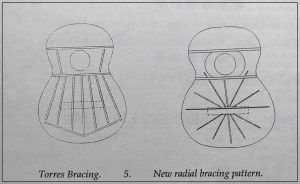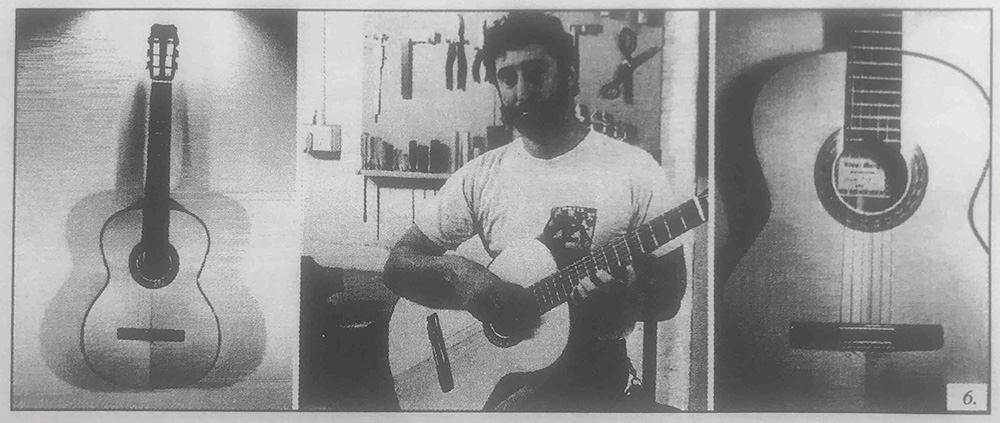
In Conversation with Simon Marty
By Austin Prichard-Levy
Simon Marty is a Sydney-based luthier whose guitars are acquiring a considerable reputation, both here and overseas, for their projection, clarity and brightness of tone.
Share this:
[feather_share]
Simon has a doctorate in electrical engineering, a background that has aided him considerably with his innovative approach to guitar design over the past eight years. Here he discusses his design approach, his researches and his guitar-making goals.

A.P-L: Simon, when and why did you start building guitars?
S.M: In 1981, after studying guitar for a number of years, I’d come to the conclusion that owning a guitar made by well-known makers like Kohno or Ramirez was no guarantee of consistency or quality. It didn’t seem possible to go out and buy a guitar with the qualities of sound that I wanted, such as good projection, clarity and evenness of tone, so I began to think about building my own. I felt that the problem might lie with the limitations of traditional guitar design and thought it would be interesting to explore non-traditional design concepts. I’m not suggesting that excellent guitars are never made with the traditional approach, but it’s rare to find consistently good guitars from any given maker.
A. P-L: So how did you go about building guitars?
S.M: Firstly I read the available literature on the physics of the instrument, how they were built and what the well known makers were doing and then designed a soundboard which I thought would have some advantages over the traditional approach. Then I started working with Gerard Gilet, who taught me the basics of guitar building and who generously shared his ideas and experience with me. Of course, my original design has evolved quite a bit over the years since then.
A. P-L: What are the main ways you sought to improve guitar design?
S.M: To begin with, I was primarily looking for ways of improving the acoustical efficiency of the guitar, but without compromising other important qualities such as evenness of tone and so on. I should point out that it is the overall soundboard design that determines the sound of an instrument. The type of timber, the way it’s thicknessed and the bracing are the main factors. Most makers use variations on the design developed by Antonio Torres last century, which I believe has reached the limits of its potential. I’d also add that peoples’ expectations of modern concert standard guitars have risen rapidly, so that what is built now has to satisfy a far more discerning player than before.
In my case, that meant abandoning the Torres-style fan-strutting approach and developing a different bracing pattern which basically consists of radial arrangement of carbon-fiber composite struts. This approach gives a lot of flexibility in controlling the sound and the energy input from the strings and is also good from the structural point of view. Also the back and sides are very rigid. It’s difficult to explain why I do this without going into a lot of detail but it’s related to the way the resonances of the top and back interact. It also affects the balance between the bass and treble response.
The approach of some makers to building more powerful guitars has been to increase the string tension by increasing the scale length, which makes the guitar harder to play. I think this approach is a mistake. It’s really necessary to rethink the design but at the same time not invent a new instrument. I like the aesthetics of the guitar very much, and I don’t particularly want to alter its traditional appearance.
A. P-L: I know that the physics of the guitar is very complex; so how did you go about testing your ideas for validity?

S.M: Primarily, I wanted to understand the way in which the soundboard was working so that I could further refine the design. This involved determining where the important soundboard resonances were and how efficiently they radiated sound. So I applied for and received a grant from the Australia Council to work with the C.S.I.RO. using laser holography to study soundboard vibrations. This was in conjunction with frequency response testing and finite element analysis computer modeling. These techniques enabled the effect of small changes in the construction to be determined rapidly and so were very valuable. I finished this stage in 1987 and published some of the results overseas.
As well, since I started building, I’ve sought the opinions of good players like Sebastian Jorgensen, Peter Altmeier-Mort and others to make sure that the changes I was making were resulting in improvements. I was also constantly comparing my guitars to guitars of conventional construction.
A. P-L: Do you think that guitar makers in general have exploited research techniques sufficiently?
S.M: Compared to the work that’s been done on the violin, the guitar hasn’t been as thoroughly studied. It seems that a lot of academically minded people are interested in the violin but not so many in the guitar. Mostly the violin research has been to reveal what the great makers of the past did whereas the guitar is still evolving.
Most guitar makers don’t have a very strong technical background or access to modern technology so it’s difficult for them to apply modern scientific techniques and some people resist departures from a traditional approach. Modern technology isn’t essential but a logical, rational approach is. I think that unless you’re adventurous and offer something different then players prefer to stick with the well-known brands. The trend in Australia is towards adopting a scientific approach where possible and builders here are very open to new methods and materials. I don’t think this is generally the case overseas where design changes are often gimmicky and seem to be marketing ploys rather than resulting from proper research.

A. P-L: Have you been influenced by other Australian makers, like Greg Smallman?
S.M: Yes, I admire Greg’s work a great deal. Greg has been objective, logical and systematic in his approach and uses an overall concept of an ideal guitar sound in the development of his instruments. His guitars are beautifully made as well. His link with John Williams has also helped him develop the sound of his guitars and gain acceptance. This has benefited Australian makers generally as people are now more willing to accept the local product. Access to good players is a necessity for any guitar maker. I’ve been lucky that good players here like Julian Byzantine and Roland Chadwick, to mention a couple, play my guitars. Certainly, the high quality of the instruments made by Greg Smallman and Richard Howell prevents me from becoming complacent.
A. P-L: What about overseas influences?
S.M: Since I’m more interested in innovative approaches to guitar design, I haven’t been greatly influenced by traditional overseas makers. Some aspect of Bouchet’s design, such as his approach to dealing cross-grain stiffness have interested me, though.
In 1983 I traveled to the U.S. and visited several well-known makers, but I have to say that overall the outcome was disappointing. I visited Richard Schneider, an American maker who uses the radical design approach developed by Kasha, but I found the guitars uninspiring. The premise underlying Kasha’s design is incorrect – that soundboard vibrations of different frequencies can be confined to small predetermined areas. The laser holography results shown clearly that this isn’t the case. I actually built a Kasha-style guitar, but on testing it I found that too much of the energy going into the soundboard was dissipated in internal friction.

I also met John Gilbert in the U.S. and was impressed by his scalloped bridge design which I started to use. It ties in well with the bracing pattern I use. The bridge design has an effect on the acoustics of the guitar, on which too many makers underestimate.
As far as Spanish makers are concerned, the main changes that I am familiar with are the Contreras double top which uses a lamination method for the back, and the little ledge that Ramirez puts inside the de Camara model. Both these devices strike me as being typical of the ad hoc approach to experimentation and frankly I feel they’re of dubious value.
I know that Dieter Hopf in Germany has done a lot of research but I don’t think it’s been published and I haven’t heard his recent guitars so it is difficult to assess the value and extent of his work.

A. P-L: Spruce is often considered a difficult soundboard timber to get good results from. How do you find it?
S.M: Spruce has a higher density than cedar, so designs that aren’t acoustically efficient don’t seem to project very well. However, I find with the construction method I use that this isn’t a problem. I’ve had quite a few players order spruce-top instruments because they like the different range of tone colors that spruce offers.
A.P-L: Finally, what are your long term plans with guitar making?
S.M: I intend to continue building guitars and also keep up my interest in engineering research at Sydney University. Ultimately I’d like to see my design incorporated into a mass manufactured guitar, so that the benefits of imported projection, clarity and consistency could also become available to guitarists who can’t afford a hand-made instrument.

ILLUSTRATIONS
- Photograph of the laboratory set-up for laser holography.
- Laser holography of a Ramirez guitar, showing the resonant modes of vibration in the soundboard.
- Flowchart illustrating the data capture sequence for the laboratory testing.
- Energy distribution of a guitar shown by frequency spectrum, using Fast Fourier Transform techniques from the data collected during laboratory trials.
- Torres bracing and the new radial bracing pattern.
- Photos of Simon Marty and his guitars.


Great article. I made the first of the two guitars in my guitar building experience in 2001 under Gerard Gilet, and learned of Simon and their collaboration. That guitar has radial bracing under spruce; the second, also with Gerard and made just over a decade later, has a lattice bracing under cedar and laminated back and sides. I seem to recall talk of that lattice also being the product of collaboration with Simon, That guitar also has a half-double top. Both have great projection. I often wonder how continuing to develop as a builder would have turned out, No regrets. It’s great to play an instrument having made it myself under great tutelage. Australian guitar making continues, and continues to develop, as it should and I’m very pleased to have been taken into that world.